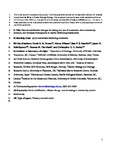Natural acidification changes the timing and rate of succession, alters community structure, and increases homogeneity in marine biofouling communities
| dc.contributor.author | Brown, NEM | |
| dc.contributor.author | Milazzo, M | |
| dc.contributor.author | Rastrick, SPS | |
| dc.contributor.author | Hall-Spencer, Jason | |
| dc.contributor.author | Therriault, TW | |
| dc.contributor.author | Harley, CGD | |
| dc.date.accessioned | 2017-10-23T20:24:20Z | |
| dc.date.issued | 2017-09-11 | |
| dc.identifier.issn | 1354-1013 | |
| dc.identifier.issn | 1365-2486 | |
| dc.identifier.uri | http://hdl.handle.net/10026.1/10083 | |
| dc.description.abstract |
<jats:title>Abstract</jats:title><jats:p>Ocean acidification may have far‐reaching consequences for marine community and ecosystem dynamics, but its full impacts remain poorly understood due to the difficulty of manipulating <jats:styled-content style="fixed-case"><jats:italic>p</jats:italic>CO</jats:styled-content><jats:sub>2</jats:sub> at the ecosystem level to mimic realistic fluctuations that occur on a number of different timescales. It is especially unclear how quickly communities at various stages of development respond to intermediate‐scale <jats:styled-content style="fixed-case"><jats:italic>p</jats:italic>CO</jats:styled-content><jats:sub>2</jats:sub> change and, if high <jats:styled-content style="fixed-case"><jats:italic>p</jats:italic>CO</jats:styled-content><jats:sub>2</jats:sub> is relieved mid‐succession, whether past acidification effects persist, are reversed by alleviation of <jats:styled-content style="fixed-case"><jats:italic>p</jats:italic>CO</jats:styled-content><jats:sub>2</jats:sub> stress, or are worsened by departures from prior high <jats:styled-content style="fixed-case"><jats:italic>p</jats:italic>CO</jats:styled-content><jats:sub>2</jats:sub> conditions to which organisms had acclimatized. Here, we used reciprocal transplant experiments along a shallow water volcanic <jats:styled-content style="fixed-case"><jats:italic>p</jats:italic>CO</jats:styled-content><jats:sub>2</jats:sub> gradient to assess the importance of the timing and duration of high <jats:styled-content style="fixed-case"><jats:italic>p</jats:italic>CO</jats:styled-content><jats:sub>2</jats:sub> exposure (i.e., discrete events at different stages of successional development vs. continuous exposure) on patterns of colonization and succession in a benthic fouling community. We show that succession at the acidified site was initially delayed (less community change by 8 weeks) but then caught up over the next 4 weeks. These changes in succession led to homogenization of communities maintained in or transplanted to acidified conditions, and altered community structure in ways that reflected both short‐ and longer‐term acidification history. These community shifts are likely a result of interspecific variability in response to increased <jats:styled-content style="fixed-case"><jats:italic>p</jats:italic>CO</jats:styled-content><jats:sub>2</jats:sub> and changes in species interactions. High <jats:styled-content style="fixed-case"><jats:italic>p</jats:italic>CO</jats:styled-content><jats:sub>2</jats:sub> altered biofilm development, allowing serpulids to do best at the acidified site by the end of the experiment, although early (pretransplant) negative effects of <jats:styled-content style="fixed-case"><jats:italic>p</jats:italic>CO</jats:styled-content><jats:sub>2</jats:sub> on recruitment of these worms were still detectable. The ascidians <jats:italic>Diplosoma</jats:italic> sp. and <jats:italic>Botryllus</jats:italic> sp. settled later and were more tolerant to acidification. Overall, transient and persistent acidification‐driven changes in the biofouling community, via both past and more recent exposure, could have important implications for ecosystem function and food web dynamics.</jats:p> | |
| dc.format.extent | E112-E127 | |
| dc.format.medium | Print-Electronic | |
| dc.language | en | |
| dc.language.iso | en | |
| dc.publisher | Wiley | |
| dc.subject | climate change | |
| dc.subject | community | |
| dc.subject | marine biodiversity | |
| dc.subject | natural analogue | |
| dc.subject | Ocean acidification | |
| dc.title | Natural acidification changes the timing and rate of succession, alters community structure, and increases homogeneity in marine biofouling communities | |
| dc.type | journal-article | |
| dc.type | Journal Article | |
| dc.type | Research Support, Non-U.S. Gov't | |
| plymouth.author-url | https://www.webofscience.com/api/gateway?GWVersion=2&SrcApp=PARTNER_APP&SrcAuth=LinksAMR&KeyUT=WOS:000426506100010&DestLinkType=FullRecord&DestApp=ALL_WOS&UsrCustomerID=11bb513d99f797142bcfeffcc58ea008 | |
| plymouth.issue | 1 | |
| plymouth.volume | 24 | |
| plymouth.publication-status | Published online | |
| plymouth.journal | Global Change Biology | |
| dc.identifier.doi | 10.1111/gcb.13856 | |
| plymouth.organisational-group | /Plymouth | |
| plymouth.organisational-group | /Plymouth/Faculty of Science and Engineering | |
| plymouth.organisational-group | /Plymouth/Faculty of Science and Engineering/School of Biological and Marine Sciences | |
| plymouth.organisational-group | /Plymouth/PRIMaRE Publications | |
| plymouth.organisational-group | /Plymouth/REF 2021 Researchers by UoA | |
| plymouth.organisational-group | /Plymouth/REF 2021 Researchers by UoA/UoA07 Earth Systems and Environmental Sciences | |
| plymouth.organisational-group | /Plymouth/Research Groups | |
| plymouth.organisational-group | /Plymouth/Research Groups/Marine Institute | |
| plymouth.organisational-group | /Plymouth/Users by role | |
| plymouth.organisational-group | /Plymouth/Users by role/Academics | |
| dc.publisher.place | England | |
| dcterms.dateAccepted | 2017-07-14 | |
| dc.rights.embargodate | 2018-8-1 | |
| dc.identifier.eissn | 1365-2486 | |
| dc.rights.embargoperiod | Not known | |
| rioxxterms.funder | Natural Environment Research Council | |
| rioxxterms.identifier.project | Assessing the effects of long-term ocean acidification at volcanic CO2 vents | |
| rioxxterms.versionofrecord | 10.1111/gcb.13856 | |
| rioxxterms.licenseref.uri | http://www.rioxx.net/licenses/all-rights-reserved | |
| rioxxterms.licenseref.startdate | 2017-09-11 | |
| rioxxterms.type | Journal Article/Review | |
| plymouth.funder | Assessing the effects of long-term ocean acidification at volcanic CO2 vents::Natural Environment Research Council |


